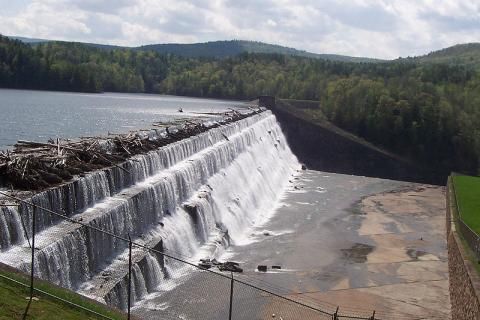
Photo: Excess water spilling over the Gilboa Dam at the Schoharie Reservoir. Image released into the public domain, courtesy of Wikimedia Commons.
At a public hearing in Kingston today, the New York City Department of Environmental Protection released some details about its ongoing effort to generate hydroelectric power at several of the city's upstate reservoirs.
The Times Herald-Record's Adam Bosch was there, and reports that the DEP's plans have shrunk considerably over the last year:
The DEP's original hopes, unveiled in 2009, called for a total of 11 hydropower turbines at the Cannonsville, Neversink, Pepacton and Schoharie reservoirs. They were expected to produce a maximum of 38.75 megawatts.
Officials trimmed that plan after a year of analysis. They eliminated all three turbines planned for the Schoharie Reservoir because there is not enough water released from the reservoir to spin the turbines and justify the investment, the DEP said. Neversink and Pepacton lost one turbine each because of limited physical space for generators.
The new plan calls for six turbines at three reservoirs, for a maximum output 16.72 megawatts.
It remains unclear what the power would be used for, or which private companies have expressed interest in working with the DEP.
A few years ago, the Delaware County Electric Cooperative -- a small, member-owned nonprofit utility company -- was actively pursuing negotiations with the DEP to develop hydropower on the reservoirs. But despite the support of local municipalities and many of New York State's highest-ranking politicians, the project fell apart.
Last year, in an interview about the DEP's current hydropower push, DCEC's Greg Starheim told the Watershed Post that he did not believe New York City had any real interest in hydropower on the reservoirs, beyond keeping other potential developers out:
“The city has considered hydroelectric generation at some of the facilities in the past, going back thirty years ago. And they've always abandoned those pursuits,” he said. “We have tried extensively to negotiate with the city and have not been successful.”
But if the DEP does not act to develop power on the reservoirs, the agency risks losing its permit from the Federal Energy Regulatory Commission, which will expire in 2012 if no action is taken.
Though the DEP's primary mission is water, not power, holding the federal permit gives the agency more assurance that any development will not harm the city's drinking water, [DEP spokesman Farrell] Sklerov said.
“By having the FERC license, DEP maintains ultimate authority over the site, which allows us to ensure the protection of our water supply and water infrastructure,” he said.
The DEP applied for their FERC permit in 2008, while the federal agency was still considering an earlier permit application by DCEC to develop power on the reservoirs. FERC gives priority to municipalities in awarding these types of permits, and the federal agency chose to award the permit to the city instead of the electric cooperative. (For more background on the DCEC's failed bid to develop power on the reservoirs, see our story from last November.)














